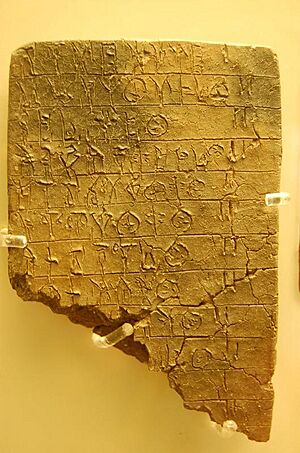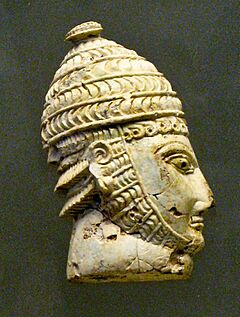Mycenaean Greek facts for kids
Quick facts for kids Mycenaean Greek |
||||
|---|---|---|---|---|
| Region | Southern Balkans/Crete | |||
| Era | 16th–12th century BC | |||
| Language family | ||||
| Writing system | Linear B | |||
| Linguist List | gmy | |||

Map of Greece as described in Homer's Iliad. The geographical data is believed to refer primarily to Bronze Age Greece, when Mycenaean Greek would have been spoken, and so can be used as an estimator of the range.
|
||||
|
||||
| This article contains text in the Linear B syllabic script and characters used to write reconstructed Proto-Indo-European words. Without proper rendering support, you may see question marks, boxes, or other symbols. |
Mycenaean Greek is the oldest known form of the Greek language. People spoke it in mainland Greece and on the island of Crete during the Mycenaean Age. This was a long time ago, from about the 16th to the 12th century BC.
We know about Mycenaean Greek from special writings called Linear B. This writing system was first used on Crete before the 14th century BC. Most of these writings are on clay tablets. They were found in places like Knossos (in central Crete) and Pylos (in the southwest of the Peloponnese). Other tablets were found in Mycenae itself, Tiryns, Thebes, and Chania in Western Crete. The language gets its name from Mycenae, which was a very important city during that time.
For a long time, no one could understand these tablets. People thought they might be written in many different languages. But in 1952, a smart person named Michael Ventris finally figured out the script. He built on the great work of Alice Kober.
The texts on the tablets are mostly lists and records. They are not stories, myths, or poems. Even so, these records teach us a lot about the people who wrote them. They also tell us about the Mycenaean Age, which happened before the time known as the Greek Dark Ages.
Contents
How Mycenaean Greek Was Written

Mycenaean Greek was written using Linear B. This writing system uses about 200 different symbols. Some are syllables (symbols for sounds like "ba" or "ko"). Others are ideograms (symbols for whole words or ideas, like "sheep" or "wheat").
Linear B came from an older writing system called Linear A. Linear A was used for a different language that we still can't understand. Because Linear B was adapted from Linear A, it didn't have symbols for every sound in Mycenaean Greek.
This meant that writers had to simplify things. For example:
- Some similar sounds were written with the same symbol.
- The letters r and l were not written differently. So, the word for "king" (which was gʷasileus) was written as 𐀣𐀯𐀩𐀄, which sounds like qa-si-re-u.
- Sounds like h were usually not written.
- Consonants at the end of a syllable or before another consonant were often left out. For example, the word for "all" (panta) was written as 𐀞𐀲, which sounds like pa-ta.
- Double consonants were not shown. So, the city Knossos was written as 𐀒𐀜𐀰, which sounds like ko-no-so.
- The length of vowel sounds was not marked.
Because of these simplifications, it can be tricky to know exactly how Mycenaean words were pronounced. Experts often use clues from later Greek words and older languages to figure it out.
Sounds of Mycenaean Greek

Mycenaean Greek had some sounds that changed in later forms of Ancient Greek. For example:
- It had special "labialized velar" sounds (like gw, kw). These sounds are made in the back of your throat while rounding your lips. In later Greek, these sounds changed into other sounds.
- It also had "semivowel" sounds (like y and w). These were mostly lost in later Greek, though w stayed in some dialects.
- The sound h between vowels was also present.
There were at least five main vowel sounds: a, e, i, o, u. These could be short or long.
Because Linear B was a simple writing system, it didn't show all the details of how words were pronounced. This makes it a bit like trying to guess a word if some letters are missing!
How Words Changed (Morphology)
Mycenaean Greek words changed their endings based on how they were used in a sentence. This is called declining for nouns and conjugating for verbs.
Nouns and Adjectives
Nouns (words for people, places, things) likely had 7 cases. Cases show a word's job in a sentence (like who is doing the action or who something belongs to). Later Greek languages lost some of these cases. For example, Modern Greek only has 4 cases.
Nouns also had 3 genders (masculine, feminine, neuter) and 3 numbers (singular, dual, plural). Adjectives (words that describe nouns) changed to match the nouns they described in case, gender, and number.
Verbs
Verbs (action words) probably changed for:
- 3 tenses: past, present, future.
- 3 aspects: perfect, perfective, imperfective (these show if an action is finished or ongoing).
- 3 numbers: singular, dual, plural.
- 4 moods: indicative (for facts), imperative (for commands), subjunctive, optative.
- 3 voices: active (subject does action), middle, passive (subject receives action).
- 3 persons: first (I, we), second (you), third (he, she, it, they).
- They also had infinitives (like "to run") and verbal adjectives.
One interesting thing is that the "verbal augment" (a small addition to verbs to show past tense) was almost never used in Mycenaean Greek. It was sometimes left out in the famous poems of Homer too.
What Makes it Greek?
Mycenaean Greek had already gone through several changes that make it clearly part of the Greek language family. These changes happened to sounds and word forms.
Sound Changes
- The sound s at the beginning or between vowels often changed to h.
- Some sounds that were "voiced aspirates" (like bh, dh) became "devoiced" (like b, d).
- Certain sounds like kj and tj changed to s before a vowel.
Word Form Changes
- Mycenaean Greek used the ending -eus to create words for people who do something (like "shepherd").
- The ending -ei was used for verbs when talking about "he, she, or it" in the present tense.
- The infinitive ending -ein (like "to do") was also present.
Unique Greek Words
Mycenaean Greek also had words that are special to the Greek language. Some examples include:
- 𐀣𐀯𐀩𐀄, qa-si-re-u, which later became βασιλεύς (basiléus), meaning "king."
- 𐀏𐀒, ka-ko, which later became χαλκός (chalkos), meaning "bronze."
- 𐀷𐀙𐀏, wa-na-ka, which later became ἄναξ (ánax), meaning "overlord" or "leader."
- 𐀁𐀨𐀺, e-ra-wo, which later became ἔλαιον (élaion), meaning "olive oil."
- 𐀳𐀃, te-o, which later became θεός (theos), meaning "god."
- 𐀴𐀪𐀡, ti-ri-po, which later became τρίπους (tripous), meaning "tripod."
Comparing Mycenaean and Homeric Greek
It's fun to see how Mycenaean Greek compares to the Greek used in famous stories like Homer's Iliad. Here are the first few lines of the Iliad translated into what Mycenaean Greek might have sounded like:
| Line | Mycenaean Greek (Linear B script) |
Transliteration of Mycenaean Greek | Homeric Greek (Greek alphabet: modern orthography) |
Transliteration of Homeric Greek |
|---|---|---|---|---|
| 1 | 𐀗𐀛𐄁𐀀𐀸𐀆𐄁𐀳𐀀𐄁𐀟𐀩𐀷𐀆𐀃𐀍𐄁𐀀𐀑𐀩𐀺𐄁 | Monin aweyde Tʰeha Pelewadeohyo Akʰilēwos | Μῆνιν ἄειδε θεᾱ̀ Πηληϊάδεω Ἀχιλῆος | Mênin áeide theā̀ Pēlēïádeō Akhilêos |
| 2 | 𐀃𐀫𐀕𐀙𐄁𐁀𐀘𐀹𐀊𐄁𐀀𐀏𐀺𐄁𐀀𐀑𐀊𐄁𐀁𐀳𐀐𐄁 | olomenān, hā=murwia Akʰaywoys algya etʰēke, | οὐλομένην, ἣ μῡρί᾽ Ἀχαιοῖς ἄλγε᾽ ἔθηκε, | ouloménēn, hḕ mūrí᾽ Akhaioîs álge᾽ éthēke, |
| 3 | 𐀡𐀩𐀷𐀆𐄁𐀂𐀠𐀴𐀗𐄁𐀢𐀱𐀏𐄁𐀀𐀹𐀅𐄁𐀡𐀫𐀊𐀟𐀮𐄁 | polewas=de ipʰtʰimons psūkʰans Awidāy proyapse | πολλᾱ̀ς δ᾽ ἰφθῑ́μους ψῡχᾱ̀ς Ἄϊδι προΐαψεν | pollā̀s d' iphthī́mous psūkhā̀s Áïdi proḯapsen |
| 4 | 𐀁𐀫𐀺𐄁𐁂𐀵𐀆𐄁𐀸𐀫𐀨𐄁𐀳𐀄𐀐𐄁𐀓𐀯𐄁 | hērōwōn, awtons=de welōra tewkʰe kunsi | ἡρώων, αὐτοὺς δὲ ἑλώρια τεῦχε κύνεσσιν | hērṓōn, autoùs dè helṓria teûkhe kúnessin |
| 5 | 𐀃𐀺𐀜𐀂𐀤𐄁𐀞𐀯𐄁𐀇𐀺𐀆𐄁𐀁𐀤𐀩𐀁𐀵𐄁𐀦𐀨𐄁 | oywonoyhi=kʷe pansi, Diwos=de ekʷeleeto gʷōlā, | οἰωνοῖσί τε πᾶσι, Διὸς δ᾽ ἐτελείετο βουλή, | oiōnoîsí te pâsi, Diòs d᾽ eteleíeto boulḗ, |
Where We Found Mycenaean Writing
We have found about 6,000 clay tablets and pieces of pottery with Linear B writing. These date from the 16th to the 12th century BC. So far, we haven't found any large stone monuments with Linear B.
There's a small stone called the Kafkania pebble that some people thought was the oldest Mycenaean writing. It was supposedly from the 17th century BC. However, many experts don't think it's real. Most scholars don't include it in their studies of Linear B.
The oldest Linear B tablets that experts agree on are from Knossos. They were found in a place called the 'Room of the Chariot Tablets'. These tablets are believed to be from the late 15th or early 14th century BC.
Different Ways of Speaking Mycenaean
Even though Mycenaean Greek seems quite similar everywhere it's found, there are small differences. These differences might show that there were different ways of speaking the language.
For example, sometimes the letter i was used instead of e in certain word endings. Also, a was sometimes used instead of o in some words.
A scholar named Ernst Risch thought that there might have been different dialects within Linear B. He called one "Normal Mycenaean." This was the standard language used in official palace records. He called the other "Special Mycenaean." This might have been the everyday way of speaking for some scribes (writers).
This idea suggests that after the Mycenaean civilization ended, the standard language disappeared. But the local ways of speaking might have continued. These local dialects could have then developed into the different Greek dialects we see in later history.
Some experts believe that Mycenaean Greek was a special "koine" language. A koine is a common language used by many people, often for official business. In this case, it would have been the official language of the palaces and ruling families. When the palaces fell, the writing system stopped being used. But the local dialects that were spoken underneath this "koine" continued to grow and change.
However, other experts have questioned this idea. They say that the differences in writing might just be due to individual scribes' habits. They don't necessarily mean there were different dialects.
Where Did it Go?
Mycenaean Greek stopped being used when the Mycenaean civilization collapsed. But some parts of it can still be found in later Greek dialects.
For example, Arcadocypriot Greek is an ancient Greek dialect that is thought to be quite similar to Mycenaean Greek. This dialect was spoken in Arcadia (in the central Peloponnese) and on the island of Cyprus.
Another ancient Greek dialect, Pamphylian, also shows some similarities to Arcadocypriot and Mycenaean Greek.

